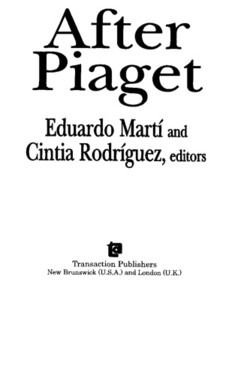
After Piaget PDF
Preview After Piaget
After Plaget Eduardo Marti and Cintia ROdI'igUCZ, editors Copyright© 2012by Transaction Publishers, New Brunswick,New Jersey. All rightsreservedunderInternationalandPaniAmericanCopyright Conventions.N0partofthisbook maybereproducedortransmitted in any form or by any means, electronic or mechanical, including photocopy,recording,oranyinformationstorageandretrievalsystem, without prior permission inwritingfrom the publisher.All inquiries should be addressed to Transaction Publishers, Rutgers—The State University of New }ersey, 35 Berrue Circle, Piscataway, New Iersey 08854-8042.www.transactionpub.corn This book is printed on acid-free paper that meets the American National Standard for Permanence of Paper for Printed Library Materials. LibraryofCongressCatalogNumber:2011039337 ISBN:978—1—4128-4165-0 Printed inthe United StatesofAmerica LibraryofCongressCataloging-in-PublicationData After Piaget/ EduardoMartiandCintiaRodriguez,editors. p.cm.—[Historyandtheory ofpsychology) 1. Piaget, Jean, 1896—1980—Political and social views. 2. Devel- opmentai psychology. 3. DeveIOpmental psychology—Research— History. I. Marti,Eduardo. II. Rodriguez,Cintia. BF713.A332012 155.4'13092—dc23 2011039337 Toour mastersfrom Geneva Contents SeriesEditor’sPreface ix RestoringPiagettothe World: LookingBackto Construct the Future lean Valsiner Preface xvii Introduction xix The FertilityofPiaget’sLegacy CintiaRodriguezandEduardoMart! Part1.BeyondPiaget’sConstructivism 1 FromConstructivismto Neuroconstructivism:The Activity-Dependent Structuringofthe HumanBrain 1 Annette Karmdofl-Smith 2 PiagetasaPioneerofDialecticalConstructivism:Seeking DynamicProcessesfor HumanScience 15 leanPdscudieLeone 3 ContributionsofPiagetianConstructivismto Social Interactionism 43 jean-Paid Bronckdrt Part2.FromAnimalto InfantandChildDeveIOpment 4 PiagetandtheComparativePsychologyofAnimal Cognition 59 Jacques Vducldir 5 BabyAssault onPiaget 71 PhilippeRocha: 6 ClinicalApproach ofthe PrematureInfant, Evaluations,andDevelopmentalCare 83 AndreBailinger 7 PiagetandConsciousness:Retrospectand Prospect 95 FranciscoPans,PaulL.Ham's,andMarcdeRosnoy Part3.SemioticChallengesalongDevelopment 8 TheFunctionalPermanenceoftheObject:A Product ofConsensus 123 CintidRodriguez 9 Thinkingwith Signs:FromSymbolicActionsto ExternalSystemsofRepresentation 151 EduardoMarti 10 The Discoveryofa“PiagetianChild”inLiteracy Development 171 EmiliaFerreiro Part4.DevelopmentthroughEducation I1 FromIndividualtoDidacticMicrogenesis:Studieson SituatedKnowledgeTransformations 187 Madden Shade-Robert 12 “ChooseTwoorThree ScapegoatsandMakeYour ,- Point!"ShouldI?CriticalThoughtsonaFabulous ExperienceandItsHeritage 207 Anne-Nelly Perret-Clemson: ListofContributors 227 Index 229 Series Editor’s Preface RestoringPiagettotheWorld:Looking BacktoConstructtheFuture This book is a gem. It breaks through the usual “Piaget-bashing” discoursethathasbeenaroundinpsychologysincethe 19803andhas become a kind ofa fashion among the many followersof the socio- cultural approachesthat captured the North American educational sciencesafterPiagetlosthisprominence.Insteadofadvancingideasm going beyond Piaget and other—by now fashionableureinvented thinkers such as Lev Vygotsky or Mikhail Bakhtin, they turned to Piaget’sheritage andscreamedinfullvoice:“Piagetwaswrong!"The gentle old man from Geneva—who was holding on to his pipe and everysummerwentupintothe Alps towrite yet anotherbook—was attributedtoallkindsoffaults. Hewassupposednottohaveconsid- eredthe“socialcontext"ofthecognitiveprocesses—untiltheEnglish language usersgotaccesstohisSociologicalStudies(Piaget, 1995)to findoutthatthiscritiquewasbasicallywrong(MaysandSmith,2001}. Socialissuessurroundingthemindwereofmuchinteresttothenatural scientistwhoseobservationalskillsfound itsbeginningin classifying mollusksattheLakeofNeach-ate].Ontheotherextreme,Piagetwas considered “out of date” for not recognizing the supposedly inborn natureofmanycognitivefunctions. Trading accusations between self-organized “camps"ofscientists ofOppositebelief systemsisnotproductivefornewideas.Insteadof such ideological discourses,what is needed is a substantive look at theactualachievementsofthecarefulthinkerandexperimenterfrOm Genevaandtheactualadvancementsofhisideasafterhisdeath.This book fillsthisgap. Itbrings together the new developmentsofideas and research practices that have grownoutofPiaget’stradition and provides a retrosPective glimpse into the intellectual atmospheres ix AfterPiaget of the different periods atwhich the authors encountered Piaget in theirGenevadays.Inaway,itisthecomplementtoFernandoVidal’s deep analysis of Piaget’sformative years-wAfter Piaget is clearly the other sideofPiagetbeforePiaget(Vidal, 1993).Continuityofideasis important to chartout(Valsiner,2010b)-—historyofascience isnot a“depository ofuseless efforts”but areservoir ofperSpectivesonce invented and maybe tried out, but abandoned. This in history has often happened for extra-scientific reasons—Jack of funding, pres- ence of aggressive competitors, ideological watchdogs of existing regimes, or political events that crush both these regimes and the intellectual work that had been going on. Piaget’slegacy, ofcourse, was not hindered by revolutions or ideological constraints—in the quietude of the Swiss environment, he could work productively with his students over decades Yet different decadesbrought with them different emphases in thework—the present book15a living testimony forthat ., ._ Jean Piagetwasaheadofhistime.While‘'beinginterdisciplinary” becamefashionable1nthesocialsciencesby theendofthetwentieth century,Piagethadbeeninnoneedforsuchgreed.Hehadputthatidea intopracticefourdecadesbefore—hebuilttherealrelationsbetween disciplinessincethe1950s.Hisbiologicalbackgroundfortifiedthedeep convictionthatpsychologyassciencecanonlybeoneofinterdisciplina arykind(Piagetand[(amii,1978).Hecreatedatrulyinterdisciplinary center—ethatofICGE(InternationalCentreofGeneticEpistemology}—— where synthesisofideas from various disciplines happened. Talking with mathematicians—rather than with statisticiansfiprovided the necessary creative impetus for Piaget’s own development of formal operationsforthescienceofgeneticepistemology.Ofcourse,onecan gowronginsuchsynthesisaswell—Piaget’sendorsementoftheBour- baki mathematics(seeAubin, 1997,pp.317—20)tookhimawayfrom thefocusofhisyoungeryearsonbuildingadevelopmentallogicalong the lines of lames Mark Baldwin (Valsiner, 2001, 2010a). Bourbaki’s mathematicscannotbedevelopmental—givenitsaxiomaticbases.Yet it was the best that mathematics as a discipline could give psychol- ogy’sepistemologymexceptforthatofthedevelopmentalperSpective. Piagetunderstood that by the endofhislife—in his discussionswith IlyaPrigogineonirreversibilityandinfinity(Prigogine, 1982). Without doubt, Piaget’s systematic efforts to bring basic math- ematics into genetic epistemology—bypassing the operation of quantificationu-was a laudable innovation. It did follow the final R SeriesEditor'sPreface suggestion ofJames Mark Baldwinback in 1930—longafterleaving thearenaofpsychology: The . . .quantitative method, brought over into psychology from theexactsciences,physicsandchemistry,mustbediscarded;forits idealconsistedin reducingthe morecomplexto the moresimple, thewholeintoitsparts,thelater-evolvedtotheearlier-existent,thus denyingoreliminatingjust thefnctorwhichconstitutedorrevealed whatwastrotbygenetic.Newermodesofmanifestationcannotbestated inatomictermswithoutdoingviolencetothemoresyntheticmodes whichobservationreveals.(Baldwin.1930,p.7,emphasesadded) Baldwin was right in 1930—Piaget tried an alternative pathway to mathematics in the 1950s—603-—yet in our present day, we see very littleprogressinovercomingthe limitations ofthe statisticalways of creating psychological knowledge Instead of abandoning statistical methodology asaxiomatically misfittingthe phenomena ofpsychol— ogy (Michell,1999),weWeill method as ifitwere the guarantorof thematifidstatumflpsycho- logicifinvestigations.Nothingcanbefartherfromthetruth—science is notificated by forcing the general linear model to, in principle, nonlinear phenomena. The mind Operates by nonlinear principles (PucheNavarro,2009,Tsuda,2001).Itisthephenomenonthatisthe criterion for deciding what science is and what it is not—from that standpoint, the best example of “anecdotal evidence” in psychology isthe inventionanduse ofthe IQtests]! Piagethadpredecessorsmgiantsonwhoseshouldershecouldcom~ fortably climb. James Mark Baldwin (2010) occupies a special place in the work of Jean Piaget (Chapman, 1988;Doise, 1989;Mays and ‘ Smith, 2001). Both his “genetic logic” and the primacy of the social asthebasis forovercomingtheegocentricityofthechild’smindwere the common roots for both him and LevVygotsky (Piaget,2000). If weweretoaddtothistheworkofHeinzWerner (Valsinelr,2005)and Edwin Holt(Charles,2011),we canbegin to see how the twentieth century thought in developmentalpsychologywas oriented to make senseoftheprocessesofdiiferentiationofthedevelopingsubjectand herorhis immediatesurroundings.Further,growthofsuchdifferen-l tiation idea is in the realm of semiotics—sign-making processes in everyday life (chapter7—Marti,2012;chapter 8—Rodriguez, 2012). Thatextension—tothefunctionalsemiosisincognition—buildsonthe best traditions ofPiaget’s childstudies,while extendingthose to the xi AfterPiaget understandingofthemeaningfulnatureoftheenvironments.Piaget’s perspectivesfitwellwithourcontemporaryinterestsinsociocultural psychology—-itwouldbedeeplyunproductivetopresentthe“Piaget- ian School”asarivaltothevaried socioculturaltraditionsofGeorge HerbertMeadorLevVygotsky. As the readers of this book will find out (inchapter 2—Pascual~ Leone, 2012), Piaget can be viewed as a thinker who was moving toward the adoptionofthe dialectical perspective in developmental psychology—advanced further by others (e.g., Riegel, 1973). The move toward creation of new dialectical models for psychology— bypassingboththeHegelianandMarxistimplementationsandtaking the qualitativesynthesisOfnew formsseriously—isthe hallmark for thefuture (Valsiner.2012,chapter 10).IntermsofPiaget’slegacy,the developmentofsuch modelscentersonjust one—but key—term1n Piaget’sthinking:equilibrationmajordnteiprogressingequilibration) Evenifthatterm issometimesmentionedwhenPiaget’5workispre— sented to various audiences, it has never been elaborated to its full implications.Theunityofassimilationandaccommodationprocesses involvestensionthatservesasthe“engine”forequilibration—thestate ofwhichcanneverbereachedbecauseitmovesfurtherawayfromthe equilibratingsubject.Reachingan equilibrium for aliving organism is an impossible outcome—it is like the effortto reachthe horizon. Thehorizon alwaysremainsaheadtotheseekerOfthegoal.Bringing thecentralnotionofthedthbesrs—dwcmleqfidmm negation—(negaationofthen1:gation)—intothemodelsofequilibration majordntewouldbearelevantbream'1nbuildinguponPiaget’s heriflge..Thatwou dcorrectthelimitationPiagetsadoptiOnoflogic— Offhe Boolean (Aristotelian) kind—had: the reliance on the Law of theExcludedMiddle.TheLawofExcludedMiddle—tOgetherwithall Aristotelian (classical)logic—does notallow for the investigation of development. Itexcludes precisely what needstobe includedu—“the middle”!AlLdE’velongnt takes placein between the gpppsites, and emergenceofnew formsstems from the tension betweenOpposites Wyntbesisofthe newform.Humandevelopmenthag; pens in the middle!TWhe thweorld, and—of thture—are1nWt15temporarily overcome—“tolead to new tensionsAn 10 icthataxiomaticall --de- CEFE'themiddletobeexcludedwplymisfit ortetaskofmaking senseofdevelwut.
